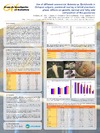Identificador persistente para citar o vincular este elemento:
https://accedacris.ulpgc.es/jspui/handle/10553/5909
| Título: | Use of different commercial Artemia sp. Enrichements in Octopus Vulgaris, paralarval rearing at initial planctonic phase: effects on growth, survival and fatty acid composition of the paralarvae | Autores/as: | Ait Chattou, M. Roo, Javier Estefanell, J. Izquierdo, Marisol Fernandez-Palacios, H. |
Clasificación UNESCO: | 251092 Acuicultura marina | Fecha de publicación: | 2006 | Resumen: | Octopus "paralarvae", are planktonic, swim actively and have high metabolic rates, requiring large quantities of live prey of adequate motility and nutritional quality ( Iglesias et al., 2000; Navarro and Villanueva, 2000, 2003). During the planktonic phase, they undergo strong morphological changes, after which the octopuses start settling to the bottom. The potential of Octopus vulgaris as candiadate for diversification of marine aquacultures are mainly due to its high food conversion rate and fast growth.( Iglesias et al 2006). Despite the research effort taken until now, paralarval rearing of O. vulgaris still suffers high mortalities which limited the industrial culture of this species. The main problems in the paralarval rearing stages are the high mortality rates and poor growth. These are attributed to the lack of standardized culture techniques and nutritional deficiencies in the diet of paralarvae, especially in n-3 highly unsaturated fatty acids (n-3 HUFA). The objective if this experience was to test different commercial live prey enrichment to improve nutritional quality of the artemia. | URI: | https://accedacris.ulpgc.es/handle/10553/5909 | Fuente: | XII International Symposium on Fish Nutrition & Feeding, 28 May - 1 June 2006, Biarritz, France | Derechos: | by-nc-nd |
| Colección: | Póster de congreso |
Visitas
48
actualizado el 10-ene-2026
Descargas
25
actualizado el 10-ene-2026
Google ScholarTM
Verifica
Comparte
Exporta metadatos
Los elementos en ULPGC accedaCRIS están protegidos por derechos de autor con todos los derechos reservados, a menos que se indique lo contrario.
